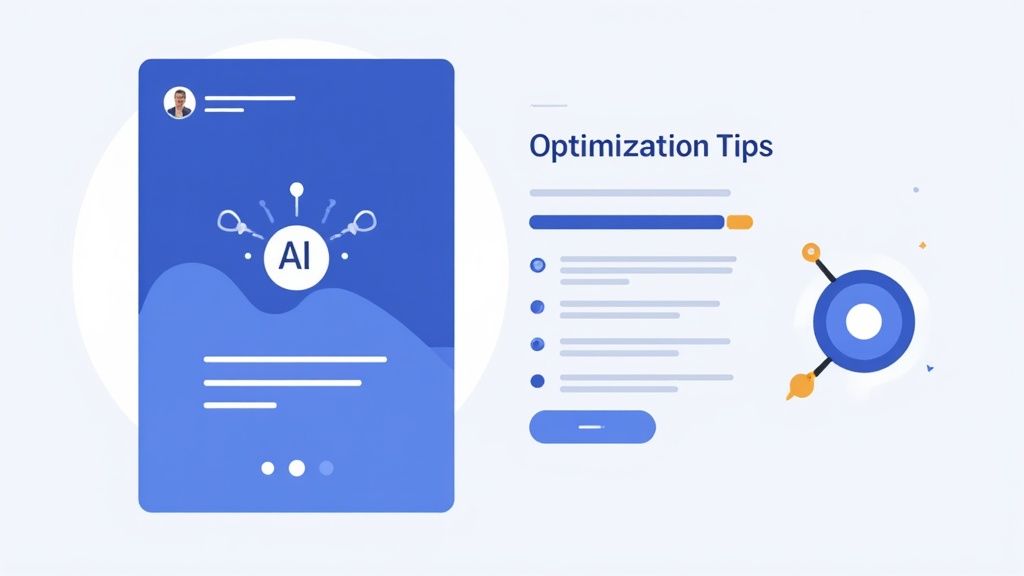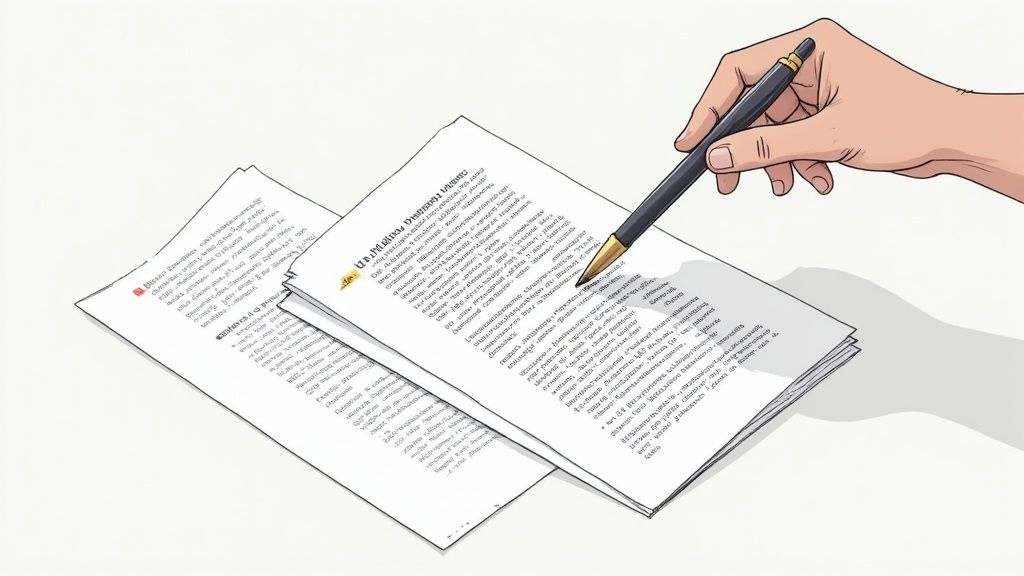Why AI Essay Writing Changes Everything
 The way we approach writing is fundamentally shifting. Modern AI is more than the clunky grammar tools of the past; it's a true creative partner. A good ai essay write tool, like our own TextSpell, doesn't just catch typos. It can serve as a brainstorming buddy, help map out a complex argument, and even propose counterpoints you might have overlooked. This isn't about letting a machine write for you—it's about making your own voice stronger.
The way we approach writing is fundamentally shifting. Modern AI is more than the clunky grammar tools of the past; it's a true creative partner. A good ai essay write tool, like our own TextSpell, doesn't just catch typos. It can serve as a brainstorming buddy, help map out a complex argument, and even propose counterpoints you might have overlooked. This isn't about letting a machine write for you—it's about making your own voice stronger.
The real talent is learning how to work with these tools in a smart way. I've talked to students who aced tough papers and professionals who've simplified their report writing with AI. The successful ones all do the same thing: they know when to let the AI do the heavy lifting and when their own critical thinking needs to take center stage. It's a conversation between human and machine, not a one-way command.
This change in writing is part of a much bigger picture. The global AI market is expanding quickly, expected to reach about $244 billion in 2025. AI essay writers are a key part of this growth, changing how work gets done in schools and businesses by adding a new layer of intelligent support. You can read more about this remarkable AI industry growth on essayservice.com. This trend shows how essential these tools are becoming in our daily communication.
Busting Common AI Writing Myths
Many people have some outdated ideas about AI-generated text. Let's clear a couple of those up so you can use these tools with a clear head.
-
Myth: "AI writing is always generic and bland."
-
Reality: A lazy prompt will get you a lazy answer. The quality of what the AI produces is directly linked to the quality of your instructions. If you learn to guide the AI with specific context, tone requests, and examples, you can get content that sounds unique and personal. It's the difference between telling your GPS "drive to the city" and giving it a precise address with route preferences.
-
Myth: "Using AI is the same as plagiarism."
-
Reality: This is a big one. Using AI to brainstorm ideas, create an outline, or check your grammar is a perfectly ethical use of technology. However, copying and pasting a full essay generated by AI and calling it your own is not. The key is collaboration and ownership. See the AI as an expert editor who is always on call; it suggests fixes and improvements, but the final ideas and the work itself are yours.
The Human-AI Partnership
The best way to use an ai essay write tool is to treat it like a partner, not an employee. You provide the core concepts, the personal stories, and the critical eye. The AI provides the processing speed, access to information, and organizational skills.
Imagine you're writing a historical essay. You give the AI your thesis statement and main points. In just a few seconds, it can:
- Generate a detailed outline that flows logically.
- Suggest primary sources or important figures you should research.
- Draft a few different introductions for you to choose from.
Then, you take back control. You weave in your own analysis and make sure the story reflects your unique point of view. This back-and-forth is where the real value is, helping you create a better piece of writing in a lot less time.
Picking the Right AI Writing Tools That Actually Work
 With so many options popping up, choosing the right tool to help you ai essay write can feel like a real chore. The market for these tools is growing fast. The AI essay generator space is projected to be worth around $250 million by 2025 and is expected to grow by about 25% each year after that. You can find more details on the growth of the AI essay generator market here. This boom means more choices, but it also means you have to sift through a lot of hype. The trick is to look past the flashy marketing and focus on what a tool can actually do for you.
With so many options popping up, choosing the right tool to help you ai essay write can feel like a real chore. The market for these tools is growing fast. The AI essay generator space is projected to be worth around $250 million by 2025 and is expected to grow by about 25% each year after that. You can find more details on the growth of the AI essay generator market here. This boom means more choices, but it also means you have to sift through a lot of hype. The trick is to look past the flashy marketing and focus on what a tool can actually do for you.
Instead of hunting for a single "perfect" tool, think about creating a small, specialized toolkit. You might use one platform for brainstorming and outlining, another for polishing your writing and checking for clarity, and a third for the final proofread. For example, a tool like TextSpell is great for generating ideas and refining drafts, but you could pair it with a specialized academic search engine to find your sources. This approach gives you more flexibility and control over the final product.
What Features Truly Matter?
When you're trying out different platforms, it's easy to get distracted by features that sound cool but don't add much real value. Here are the core capabilities you should really be looking for:
- Tone and Style Adjustment: Can the AI shift its writing style to sound academic, casual, persuasive, or analytical? A good tool will let you guide its voice to fit the specific requirements of your assignment.
- Source Integration: Some advanced tools can help you find and even cite sources. While you always need to double-check these yourself, this feature can be a major time-saver, especially for research-heavy essays.
- Prompt Understanding: The best AI writers can make sense of complex instructions. Put this to the test with a detailed, multi-part prompt. Try something like, "Draft an introduction for an essay on the economic impact of the printing press, focusing on merchants in 15th-century Venice, written in an academic tone." A weaker tool might give you a generic history lesson, but a strong one will provide a focused and relevant starting point.
- Iterative Refinement: How easy is it to ask the tool to rephrase a sentence, elaborate on a point, or suggest different wording? The ability to collaborate with the AI and fine-tune the text is essential for a quality ai essay write experience. To see this in action, check out our guide on the capabilities of a modern AI writing assistant.
To help you sort through the options, here's a look at some of the popular AI writing tools available today.
Popular AI Writing Tools Comparison
| Tool Name | Best For | Key Features | Pricing Range | User Rating |
|---|---|---|---|---|
| TextSpell | All-around essay writing, from brainstorming to final polish | Tone adjustment, source suggestions, iterative refinement, plagiarism checker | Freemium, with paid plans from $10/month | 4.8/5 |
| Jasper AI | Marketing content and long-form articles that need a creative touch | Multiple templates, brand voice features, strong content generation | Starts at ~$39/month (billed annually) | 4.7/5 |
| Copy.ai | Quick brainstorming, generating outlines, and overcoming writer's block | User-friendly interface, variety of pre-built prompts, team collaboration | Free plan available, pro plans from $36/month | 4.5/5 |
| Grammarly | Polishing grammar, style, and clarity in existing drafts | Advanced grammar checks, tone detection, plagiarism checker | Free version, premium starts at $12/month | 4.6/5 |
This table shows that different tools excel in different areas. A tool like TextSpell is built for the entire essay process, while something like Grammarly is best for the final editing stage. Your ideal choice depends on where you need the most help.
Testing AI Tools Without Wasting Your Time
Most platforms offer a free trial or a freemium plan. Make the most of this opportunity. Rather than feeding it a simple, generic task, challenge it with a real-world writing problem you're currently facing.
For instance, take a paragraph from an essay you've recently written and ask the AI to improve it. Compare its suggestions to your original. Did it just swap out a few words, or did it genuinely enhance the flow and clarity? Another effective test is to give the exact same prompt to two or three different tools. You'll quickly see which one understands the nuance of your request and which one provides a bland, cookie-cutter response. This direct comparison is the most reliable way to find a tool that fits your personal writing style and needs.
Writing Prompts That Get Amazing Results
The quality of your conversation with an AI tool directly shapes the quality of its response. This isn't about learning some secret code; it's about treating the AI like a brilliant but very literal assistant who needs clear, specific instructions. To get exceptional results when you use an AI essay writer, you need to master the art of the prompt.
Average prompts lead to bland, generic text—the kind of writing that admissions officers or professors, after reading dozens of essays, can spot from a mile away. My experience shows that when different people use similar, basic prompts, the AI produces essays that, while not identical, often share a "machinic blandness" with common phrases and recycled structures. Your job is to break out of that mold.
The secret sauce is providing rich context. Think of it like giving a friend directions. "Write an essay about World War II" is as helpful as saying, "Drive me to the city." Sure, you'll end up somewhere, but it won't be the scenic or most efficient route. A much better prompt would be: "Act as a historian specializing in naval warfare. Draft a 300-word introduction for an essay arguing that the Battle of Midway was the decisive turning point in the Pacific Theater. Use a formal, academic tone and mention the strategic importance of aircraft carriers." This level of detail gives the AI the necessary guardrails to create something genuinely useful.
The Anatomy of a Powerful Prompt
A truly effective prompt usually weaves together a few key ingredients. Once you get in the habit of including these, you'll see a huge improvement in the drafts you get back.
- Role-Playing: Give the AI a persona to adopt. Start with "Act as a literary critic," or "You are a marketing expert." This simple command immediately focuses the AI's knowledge base and sets the right tone.
- Context and Background: Briefly explain the "why" behind your request. Are you writing for a college application, a business blog, or a personal reflection? Specifying the audience helps the AI select the appropriate vocabulary and level of complexity.
- The Specific Task: Clearly state what you want the AI to do. Be direct: "Generate three potential thesis statements," "Create an outline with three main points and supporting evidence," or "Rewrite this paragraph to sound more persuasive."
- Constraints and Formatting: Give the AI rules to follow. This includes things like word count ("Keep it under 150 words"), tone ("Write in a conversational and encouraging tone"), or structure ("Present the answer as a bulleted list").
For instance, here's a prompt that combines all these elements to kickstart an essay on renewable energy:
"Act as a climate policy analyst. I'm writing an argumentative essay for a college-level environmental science class. My goal is to persuade skeptical readers that solar power is a viable primary energy source for residential homes. Draft an opening paragraph that grabs the reader's attention with a surprising statistic and clearly states this thesis. The tone should be authoritative but accessible."
This detailed instruction helps the AI understand its role, the audience, the specific task, and the desired output, leading to a far more targeted and effective result from the get-go.
Iteration Is Your Superpower
Your first prompt is almost never your last. The real magic happens when you begin a back-and-forth conversation to refine the AI's output. Think of the initial draft as a lump of clay; now, it's your turn to shape it into something refined.
Here's an example of an iterative prompting process shown in a real tool like ChatGPT.
This image perfectly illustrates how you can build on a previous response, asking the AI to tweak, expand, or rephrase its output.
Instead of hitting the "new chat" button, give follow-up commands. Try something like, "That's a good start, but can you make the language more vivid?" or "Expand on the second point with a real-world example." This iterative process is what transforms a generic draft into a polished piece of writing that truly reflects your own ideas and voice.
If you're looking for hands-on practice, challenges like the 7 Days of Prompting can help you build these crucial conversational skills. By treating the AI essay writing process as a dialogue, you maintain complete creative control while letting the AI handle the heavy lifting.
The Perfect AI-Human Writing Workflow

The most effective way to use an AI essay writer isn't to just hit "generate" and walk away. The best results come from a real partnership between your own ideas and the AI's ability to process information. This isn't about letting a machine do your thinking for you; it's about creating a workflow where you and your AI assistant work together to produce something better than either of you could alone.
Think of it as a series of distinct phases rather than one single action. You're the project manager, giving specific assignments to your AI at each stage. This keeps your voice and perspective front and center, while the AI handles the heavy lifting—like outlining, finding data, and producing initial drafts. It's a reliable method for getting from a blank page to a polished essay with less stress.
The demand for these kinds of collaborative tools is growing fast. The global essay writing platform market, which includes these AI tools, was valued at about USD 1.8 billion in 2023 and is expected to hit USD 4.5 billion by 2032. This growth shows a clear need for tools that do more than just generate text, but also offer grammar checks, plagiarism detection, and helpful feedback. You can find more details in the full report on the essay writing platform market.
The Four Phases of AI-Human Collaboration
Breaking your writing process into four distinct phases can help you avoid the bland, generic text that often comes from relying too much on AI. This structure ensures your final paper is sharp, insightful, and sounds like you.
Phase 1: The Idea and Outline Sandbox
This is where you take the creative lead, using the AI as a brainstorming buddy. Instead of a vague prompt like "write an essay about climate change," guide the conversation with your own curiosity.
- You: "I want to explore the psychological reasons people don't adopt sustainable habits. What are some major theories?"
- AI: Might return concepts like cognitive dissonance, optimism bias, and social norming.
- You: "Perfect. Let's focus on cognitive dissonance. Can you build an outline with three main points for an essay arguing that public information campaigns often backfire by causing this psychological discomfort?"
In this stage, you are the strategist. The AI is your incredibly fast research assistant, pulling concepts and arranging them into a structure you've defined.
Phase 2: The Co-Drafting Studio
With a solid outline in hand, you can ask the AI to start fleshing out the sections. The trick here is to work paragraph by paragraph, not generating the whole essay at once. This micro-management approach keeps you firmly in control.
Prompt the AI to draft a paragraph for each point in your outline. As soon as it's done, you step in. Your job is to rewrite the AI's functional text, injecting your own voice, adding smooth transitions, and making sure it connects to the previous paragraph. This is a great point to cross-reference a guide on proper structure, like our article on essay format examples, to ensure a logical flow.
Phase 3: The Refinement Workshop
Once a full draft is complete, the roles shift. You become the critical editor, and the AI becomes your go-to tool for stylistic improvements. Start by reading the draft aloud to catch any awkward phrasing. Then, use the AI to fix specific issues.
- "This sentence feels clumsy. Give me three clearer ways to say this."
- "The tone in this part is too informal. Can you rewrite it to sound more academic?"
- "This argument needs a more powerful concluding sentence. Draft one for me."
This back-and-forth process of spotting a problem and having the AI suggest solutions is what takes your writing from decent to excellent.
Phase 4: The Final Polish and Proofread
For the final step, let the AI do what it does best: spot objective errors. Run your finished document through the AI for a final check of:
- Grammar and spelling
- Punctuation mistakes
- Consistency (for instance, making sure a name is spelled the same way throughout)
This last automated review frees you up to concentrate on the bigger picture—the strength of your arguments and the clarity of your message—while knowing the minor details are taken care of.
Staying Ethical While Using AI Writing Tools
As we bring AI tools deeper into our writing process, the line between helpful assistance and outright dishonesty can get a little fuzzy. The real question isn't if you should use an AI essay writer, but how you use it. To explore this new area, you need a solid ethical compass to make sure you're using technology to elevate your work, not to pass off someone else's (or something else's) as your own. The idea is to keep your academic and professional integrity while still getting the benefits from these powerful platforms.
The biggest worry for many is unintentionally plagiarizing or committing academic dishonesty. That's a fair concern. One admissions officer shared a story about reading scholarship applications and noticing that multiple essays felt strangely similar. They described a "machinic blandness" and a feeling of déjà vu. While the essays weren't exact copies, they used common phrases and had a similar structure—a dead giveaway that the applicants had all given an AI the same generic prompt. This is a huge lesson: when lots of people use the same basic prompt, the results often have a robotic, unoriginal quality that's easy to spot.
Drawing the Line: Assistance vs. Dependence
Knowing where to draw the line is everything. A good way to think about it is to ask yourself: would I ask a trusted professor or mentor to do this for me? You would definitely ask them to look over your grammar or help you brainstorm some ideas. However, you'd never ask them to write a draft for you that you could then just tweak and submit. This simple mental check is a great guide for using AI ethically.
When you use an AI essay writer as an assistant, you're the one steering the ship. You're coming up with the main ideas, building the arguments, and adding your own unique voice to the text. When you become dependent on it, the AI is doing the heavy lifting and the thinking, and you're just proofreading. That's where the ethical red flags start to pop up.
Practical Guidelines for Ethical Use
To keep your work authentic and maintain high standards, it's smart to have a clear set of personal rules. This is especially true in formal environments like school or the workplace, where official policies on AI are still catching up.
Using AI responsibly means navigating different rules depending on the situation. What's perfectly fine for a personal blog post might be a major issue in a university paper. To help you sort it out, here's a table outlining some general guidelines.
AI Writing Ethics Guidelines by Context
Ethical considerations and best practices for using AI writing tools in different professional and academic contexts
| Context | Acceptable Use | Required Disclosure | Red Flags | Best Practices |
|---|---|---|---|---|
| Academic Essays | Brainstorming, creating outlines, checking grammar, finding ideas for sources. | Check your institution's specific policy. Many now require you to disclose if AI was used for anything beyond basic proofreading. | Generating entire paragraphs or the whole essay; using AI analysis and presenting it as your own original thought. | Use AI to get your initial structure, then write the actual draft yourself. Always cite every source manually. |
| Professional Reports | Summarizing large sets of data, creating first drafts of standard report sections, rephrasing sentences for better clarity. | This depends on company policy. It's often a good practice to let your team know if AI had a significant role in the document's creation. | Making up data or statistics; creating an analysis without truly understanding the information behind it. | Fact-check every piece of AI-generated information. Make sure the final report reflects your professional expertise and judgment. |
| Creative Content | Generating story prompts, exploring different writing tones and styles, getting past writer's block. | Usually not required, unless you're submitting to a contest or publication that has specific rules against AI-generated content. | Submitting a piece written entirely by AI and claiming it as your original, creative work. | Think of the AI as a creative collaborator. Use its output to ignite your own imagination and build something new from there. |
This table shows that the key is transparency and ownership. For school and work, always check the official rules first.
Ultimately, your name is attached to the final piece of writing. Every word should be something you can confidently stand behind, whether you wrote it from scratch or polished it with AI's help. By using these tools responsibly, you can produce better work more efficiently without sacrificing the integrity and unique voice that make your writing truly yours.
Advanced Techniques for Professional Results
 Getting past basic prompts is what separates functional AI-assisted text from truly professional writing. This is the point where you stop using AI as just a writer and start treating it like a specialized editing team. It's about ensuring a consistent voice throughout a long research paper or developing a distinct style that still feels like you. Pro users don't just generate text; they coordinate a set of tools and methods to get a very specific result.
Getting past basic prompts is what separates functional AI-assisted text from truly professional writing. This is the point where you stop using AI as just a writer and start treating it like a specialized editing team. It's about ensuring a consistent voice throughout a long research paper or developing a distinct style that still feels like you. Pro users don't just generate text; they coordinate a set of tools and methods to get a very specific result.
One of the biggest giveaways of AI-generated content is its "machinic blandness"—a term for writing that is grammatically correct but lacks any personality or memorable voice. To counter this, experienced AI users actively shape the AI's output with more detailed instructions. This involves moving beyond simple requests to inject your own personality and nuance into the text.
Crafting a Unique AI-Assisted Voice
To get a professional-grade ai essay write result, you have to teach the AI your personal style. This is an advanced skill that feels more like a two-way conversation than a simple command.
Begin by feeding the AI a sample of your own writing—a paragraph or two that you think really captures your voice. Follow it with a prompt like this: "Analyze the tone, sentence structure, and vocabulary of the text I just provided. Now, using that same style, write a paragraph about the importance of renewable energy." This process trains the AI on your specific writing habits, helping it produce text that sounds much more like something you would naturally write.
This technique is essential for maintaining consistency in longer essays. You can periodically "remind" the AI of your preferred style to keep the tone from drifting. For example, after drafting a few sections, you could ask, "Can you review the last three paragraphs and adjust them to better match the confident, analytical tone from the initial sample I gave you?" This kind of active management leads to a much more cohesive final piece.
The Multi-Tool Workflow for Complex Projects
Serious writers seldom stick to just one tool. Instead, they build a personalized workflow, using different platforms for what each does best. This approach gives you far more control over the final essay.
- Ideation and Research: Kick things off with a tool like TextSpell for initial brainstorming and to generate thematic outlines. At the same time, you can use a dedicated academic search engine AI to collect potential sources and read through abstracts.
- Drafting: With your outline and sources ready, instruct your primary ai essay write platform to draft individual sections. The secret here is to give it the specific information you want it to include, guiding its output instead of just accepting the first draft.
- Refining and Editing: Paste the drafted text into a grammar-focused tool like Grammarly for a deep polish. Simultaneously, you can use your main AI to work on stylistic improvements. Try asking it to "find any passive voice in this text and suggest active alternatives" or "rephrase these sentences to be more concise."
This multi-tool method creates a natural system of checks and balances. When you know how to organize your writing process this way, you can construct a more coherent and well-supported argument. To explore this further, check out our guide on essay structure examples, which can help you lay a solid foundation for your AI-assisted drafting. This strategic mix of tools and a strong structural plan is what takes an essay from good to great.
Your Next Steps in AI Essay Writing
Making the jump from just reading about AI to actually using it for your essays is where the real magic happens. The aim is to create a personal writing system where AI becomes a natural part of your workflow. This isn't about getting through a single assignment; it's about building a skill that will help you in various classes and even in your future career.
Don't try to boil the ocean on your first attempt. Pick a small, low-stakes assignment to start—maybe a discussion board post or a brief reflection paper. This gives you the freedom to play around with different prompts and AI features without the pressure of a big grade looming over you. The idea is to get comfortable with the human-AI partnership we've talked about, moving from brainstorming and outlining to co-drafting and polishing your work. Once you feel more comfortable, you can start using these methods for bigger, more research-intensive essays.
Building Your Personal AI Writing System
What really separates someone who just dabbles in AI from someone who is truly proficient is having a consistent process. To develop your own system, try these practical steps:
- Track Your Progress: Keep a simple document or notebook where you log the prompts you try and the responses you get. Make notes on what was effective and what fell flat. Over time, this personal "prompt library" will become a huge asset, helping you get the results you want much faster.
- Identify Weak Spots: Be honest about where you struggle in the writing process. Is it getting started with brainstorming? Or maybe organizing your arguments logically? Perhaps it's just polishing the final tone. When you pinpoint a weak area, you can direct your AI use to specifically strengthen that skill.
- Stay Informed: The technology behind AI writing tools is always getting better. Following blogs or newsletters that cover AI can keep you up-to-date on new features and better techniques, ensuring your personal system stays sharp.
This process is all about putting theory into action. By taking these deliberate steps, you'll go from simply using an ai essay write tool to mastering it as a genuine creative partner.
Ready to build your own advanced writing system? TextSpell brings all the necessary tools together in one place, from our interactive Chat Ask AI to our smart Continue Writing feature. Start creating higher-quality essays today with TextSpell.

